#multiplayer game architecture
Explore tagged Tumblr posts
Text
Pirate Software's "rearchitecture" for Stop Killing Games
There's been a lot of fascinating drama around Stop Killing Games. Go read the initiative here:
It is a good initiative, and anyone who is a consumer that can, should absolutely go support it.
Jason "Thor" Hall, CEO of Pirate Software, recently had a few, let's say, "takes" on the matter (I'm trying and failing to remain neutral), which began on a stream. The stream's VOD has since deleted on his YouTube channel.
Louis Rossmann, who you might know as the largest Right to Repair activist in the US, made a response to a section of the releevant stream here:
youtube
Thor, CEO of Pirate Software, made two videos to clarify his points:
youtube
There is an argument in the video at the 2:08 mark that I will reference later.
youtube
(I recommend watching all these videos on 2x speed. You will get the same info out of them all, because especially video 2 is a lot of repetition)
Now, as mentioned above, there is one particular technical argument that bugs me about what Thor, CEO of Pirate Software, is making. Here is the full quote:
How would you keep League of Legends in a functional, playable state? You'd have to rearchitect the entire game. The game is what is called "client-server". So, in client-server models, there's a server, there's a client, and all of the math, all of the game, everything happens on the server. The client just displays it. And the reason we want to do it that way is so that you can't teleport around and do a billion damage. You don't trust the client. You trust the server. The client just displays what it's told. Right? So, if we wanted to rearchitect this, we would have to take all of that server logic, push it back out into the client, and somehow make that playable in a multiplayer-only video game. That doesn't make sense to me. So this doesn't work for all games. Why is [the initiative] calling out all games?
So, first off, yes, most games do client-server architecture for multiplayer logic, because you do trust the servers. It is an important step to curbing an entire class of cheats. It doesn't necessarily mean the client isn't malicious (for example, there are cheats for League of Legends that show a growing circle when an enemy leaves the fog of war in the minimap). However, it does mean the client doesn't know 100% of the game at any time when information is selectively fed to each client based on something like the fog of war. That's awesome.
Some games, like PlanetSide (rest in peace) and Overwatch (2) use what's called client-side hit detection. Some games, like Halo 1, employ more selective hit detection models, where only certain weapons use client-side hit detection (see https://c20.reclaimers.net/h1/engine/netcode/). Client-side versus server-side hit detection can change the overall feel of a game, and it's one of the things game developers decide on in multiplayer-only games that require it. In the case of an massively multiplayer online first person shooter (MMOFPS) like PlanetSide (2), the server simply can't calculate thousands of people's math in a reasonable amount of time, because otherwise the hit detection would otherwise feel very crappy to play, and so the math is offloaded to the client and the client says "hit" when they hit.
However, there are a few counterexamples to the specific technical argument that keeping the game playable after end-of-lifing it requires rearchitecting:
Games with dedicated servers exist - Command & Conquer: Renegade, Starsiege: TRIBES
Games where one client also hosts the multiplayer server exist - Half Life 2, Warhammer 40k: Space Marine
Private server hosting exists - World of Warcraft
Some of these games, particularly the examples with dedicated servers that can be run on user hardware, can also run as the second example.
To say keeping a multiplayer-only online game requires rearchitecting a game like League of Legends means a lack of imagination. More relevantly, it means a lack of systems thinking.
To me, it is very strange for someone such as Thor, CEO of Pirate Software, who is self-described as being a 20 year veteran of the games industry to say. I won't say skill issue, because I think there is an ulterior motive at play.
Just to hammer the point home, I drew up some crappy diagrams in Inkscape because this extremely wrong technical argument bugged me so, so much.
Here is what a client-server model looks like:

Here, you have 10 clients, each being a player of the game. Then, you have the server, run by Riot, the developer and maintainer of League of Legends.
Here is the imagination of Thor, CEO of Pirate Software, had to say on the matter on the required way rearchitect it:

Those who know their network models would understand this looks very much like a mesh network, or a peer-to-peer model. And, to be fair, some games might attempt it.
However, this isn't *usually* how games described using a peer-to-peer (P2P) model work. Most peer-to-peer models, like the architecture used in Space Marines, are often used for matchmaking. Once you are in a game, one of the clients also serves as the host (selecting by some algorithm, like randomly or whoever has the best hardware).
P2P is nice, because the company doesn't have to run servers for matchmaking at all during their lifespan (and sometimes a matchmaking server might be spun up to serve as a relay to help with network issues or help other clients find clients quickly). As we'll get into later, a client machine will also serve as the host machine. It is a perfectly fair and valid, although it comes with it's frustrations (mainly in the realm of network address translation (NAT) traversal, because your computer behind a router is not usually exposed to the wider Internet, though sometimes routers have universal plug-and-play (UPnP) set up, which makes NAT traversal much easier here).
If you've ever seen a message in the game "migrating host" because the host left, they likely use P2P matchmaking, but still use a client-server model. They can just migrate the game data to a new host using the data on the other clients as a seed for the data.
This is likely their setup for actual gameplay:

One of the clients now has a server on the same machine. Sometimes, this could be the game itself that would serve in singleplayer. However, most often, this is just a server that's lightweight enough for the client to connect to and they play that way (it's also really nice to develop and QA this way, because many server bugs will also be seen by the client).
Now, one of the disadvantages here is: Can all remote clients connect to the host that the server (and one of the clients) is running on? Again, NAT traversal issues usually play a role here. In the first few days of any game that uses this, and only this, there will likely be a lot of issues with connectivity.
Another disadvantage: The host won't have latency issues. This is why in the case of, for example, Among Us, the client host can see certain things happening (like someone is dead the moment they hit a button or reported a body), but remote player hosts might not.
Okay, so, maybe it's not possible to rearchitect something like League of Legends like this. It could reasonably be a lot of work. Here is another solution:

Looks very similar to the first architecture, doesn't it? It is! The difference is that the text "Riot" was changed to "not Riot".
This is how World of Warcraft and Pokemon Go private servers work.
The vast majority of games that would not run without private servers simply do not require rearchitecting to keep in a reasonably playable state when the servers shut down.
#stop killing games#pirate software#software architecture#software development#multiplayer game development#Networking#League of Legends#Among Us#PlanetSide#Starsiege: TRIBES#TRIBES#Half life 2#World of Warcraft#Pokemon Go#Warhammer 40k: space marine#command & conquer: renegade#Youtube
6 notes
·
View notes
Text
good progress on a nether platform connecting peoples portals together!!
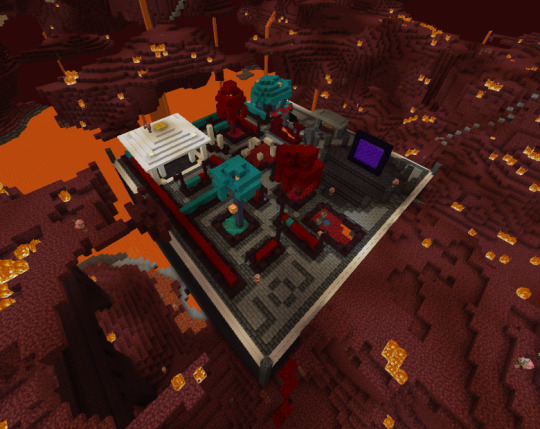
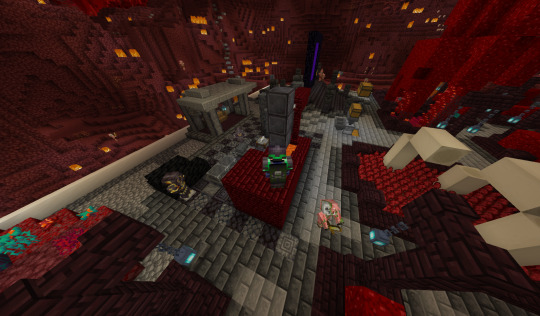
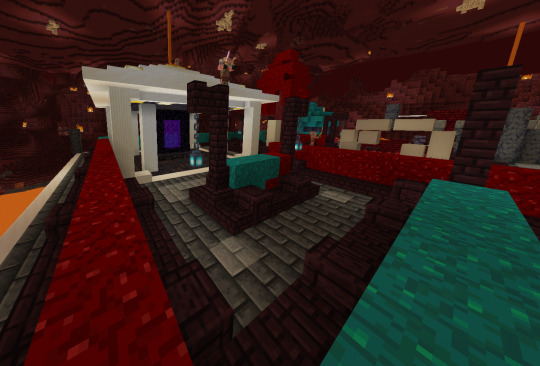
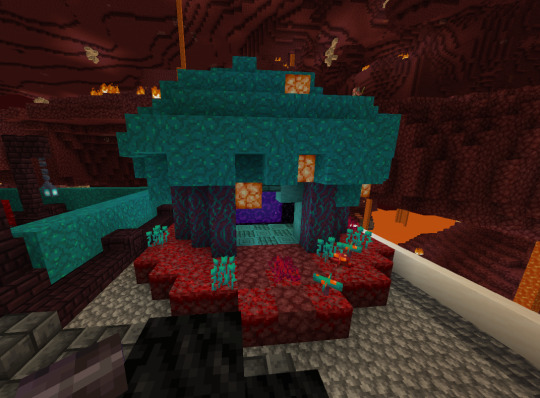
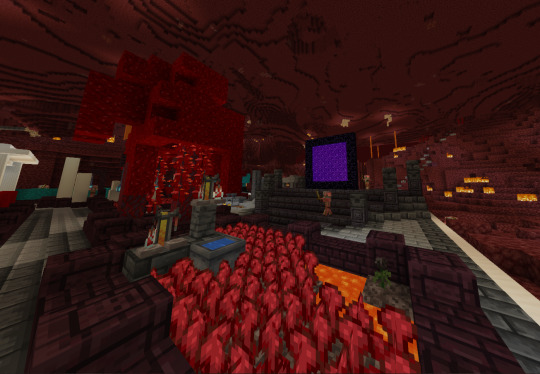
based on my silly doodles

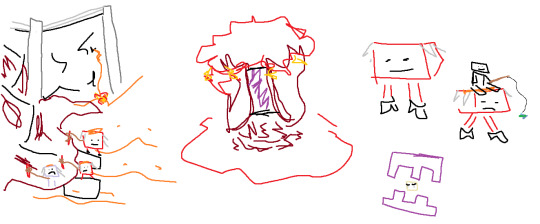
4 notes
·
View notes
Text
Goddamn I'm bad at this.
“this fic was written by AI”

#back of through#snake pit#how to rank up#how to play Tumblr#play store#says free#what is a bot?#discord?#used to load faster#oh last lesson:#vendor lock-in#switching cost#xbox computer architecture#playstation architecture#why does co-op struggle?#pc master race#game development#game theory#economics 101#why do multiplayer games fail#huge pond small fish#lionfish#invasive species#p.e.t.a. is unpopular like that granger girl#what's my name again?#“hink”#“think”#think#think think#rhymes with gordon
6K notes
·
View notes
Text

Icarus, and the Sunflower
A Desert Duo/Scarian AU about an avid player meeting his favorite, comfort character in a death loop video game.
I can’t write a fic, nor have time to draw comics like i used to, so we are doing bullet points on a tumblr post
PART ONE: BEFORE THE ALPHA TEST

PROLOGUE: PART TWO
2.1k words below the cut
SOME BEGINNING NOTES: - This AU is only character shipping, and references a lot outside the life series events (evo, hermitcraft, empires, etc). This is not meant to ship the CC’s themselves and if anything alludes to it, it is purely unintentional. - This is not canon-compliant ermmmm i do what i want and i will put every idea i have into this - Tags for this part? Game dev AU, Grian is whipped for Scar, some characters are real and some are fictional, this is only the prologue, absolutely not beta'd i only have one impulsive braincell
A. Gria
Gria is a single man in his late 20s; he works at a game company called E.V.O. Games (Entertainment Virtual for Everyone). He was an architecture graduate who dabbled in game dev in his spare time during his undergraduate studies. Although he didn’t pursue that path, he utilized his skills in level design. He used to work in several indie game companies, one of which was a company founded with friends, before he was hired by E.V.O. Games. He was excellent at his job, and his ideas and inputs always improved whatever project he worked on. Because of this, after a few years, he was promoted to creative director.
His latest project was “The Evolutionists’ Portal,” a 3D pixel-style puzzle game in which the player has to navigate the world to find portals hidden in each level, and these portals progress the game. With each portal traveled into, the world becomes bigger and more complicated, making each portal harder to find. However, with multiplayer, this task is easier through working together (and doing fun shenanigans together).
It had a buggy release, especially for multiplayer, but it built a decent player fanbase; the story itself was short and simple, but it was replayable thanks to its multiplayer mode.
For visualization, it’s 3D with a top-down perspective like “Pokemon Diamond/Pear/Platinum” but has gameplay similar to “Stardew Valley”
Gria and his team get along well, and he is quite close to some of them:
Martyn: an audio engineer. This is the first game he’s worked on since he was first hired in the company.
“Big B”: a VFX artist. He and Gria joined the company around the same time and bonded over stressful deadlines and annoying seniors when they started out.
Jimmy: the project manager. Although Gria takes a lot of joy in teasing him, he is hardworking and great at keeping everyone in check with the calendar. Out of everyone, he is the one Gria is closest with. He also works on another game by the company called “Empires.”
Pearl: an environment artist. She joined the company a bit later in the development. It is her first time dealing with pixel graphics but she did it incredibly well. She also works on “Empires” with Jimmy.
“Empires” is a free-to-play fantasy open-world action gacha RPG. It is the biggest game of the company and their title game.
For visualization, it’s just “Genshin Impact” and “Honkai: Star Rail”.
Recently, there was a buzz around that their game, “Empires”, will have a collaboration event with another big name. Gria was too busy and overworked to take notice of this, though.
The fruits of his labor later came as game nominations for “Best Multiplayer” and “Best Audio Design.” Gria was happy their work was acknowledged by players worldwide, even if they didn’t win.
B. Hermitopia
After so long, Gria finally took a week off. It was foreign to have no obligations for even a day. He doesn’t use this time to travel; instead, he sits at home and lurks on the internet to keep up with gaming news and updates. He uses the username “Xelqua” with a red macaw as his profile picture.
He stumbled upon a “Redstone tutorial” post by the user ”Potatonutshell”. Curious and intrigued by how such a complicated contraption is possible in a game (and bored out of his mind), he asked this user what game it was for. Potatonutshell briefly, and over-excitedly, DM’d Gria with a huge wall of text about this game called “Hermitopia 6.”
In the beginning days of his break, Gria spent time messaging this Potatonutshell fella, named “Mumbo.” Mumbo named himself after a character named “Mumbo Jumbo”, who is one of the most skilled “redstoners” in the game. He related heavily with the character and took a lot of interest in the redstone circuitry game feature as he is a programmer in real life. Gria thought the game was interesting, but not enough to install a 36 GB game for $39.99. He changed his mind when Mumbo told him more about the game, especially its base-building mechanic.
“Hermitopia 6: Hermit Civil War” is an open-world fantasy action RPG known for its base-building core mechanic. It is the sixth game in the franchise, and each game starts in a brand-new world. The player and the lovable NPCs are called hermits, a band of humans, fae, hybrids, and other species who live together on an island and work together to live a sustainable life amidst the hostile creatures that roam the world.
For visualization, it’s like “Skyrim” with “Baldur’s Gate 3” graphics and dialogue UI.
Gria planned to try it for a few hours, only humoring his new internet friend, until he met this beautiful NPC named “Scar Goodtimes” — a human-vex hybrid with scars all over his “handsome face and carved body”, as Gria would personally describe him. He was also a builder who lived near Gria’s very odd underwater base. Throughout the remaining days of his break, and his weekends after that, Gria played Hermitopia 6 religiously.
Scar calls him “GRIAN”, which was a typo error — Gria pressed enter early in the name selection screen and he didn’t realize it until Scar first mentioned his name 3 hours into the game. He can’t be bothered to fix it, though (and he's grown fond of it.)
Gria continued to play the game in his free time, slowly falling in love with the game as he kept on playing. He also kept talking to Mumbo, who he fanboyed about the game with. He found out that Mumbo lived close by too, so they hung out frequently and bonded over the game.
Gria: I genuinely thought you had a big mustache, y’know, like Mumbo Jumbo. Mumbo: I do too! It’s... it's there! [he shows his very faint mustache] It's there! Gria: sure.
Xelqua started off as a lurker, to an active Hermitopia fan account. He was interested in the base-building aspect of the game and shared his designs online.
Hermitopia is not a dating simulator. There is no romance mechanic in the game. Anyway, Gria installed (and tweaked) a romance mod because no one can stop him from flirting with his fictional vex boyfriend.
Mumbo: Grian, if I hadn't met you personally, I would've pictured you as a crazy Scar fanatic. Gria: Wha— How— I’m not crazy. Mumbo: You downloaded a romance mod just to flirt with Scar and commissioned an artist to draw a scene from it, and now you have it framed on your bedroom wall. So, Grian, I think that’s crazy behavior. Gria: … I do what I want, Mumbo!
Gria's love for the game and Scar grew more as another hermitopia game was released (Hermitopia 7). Then, he, as Xelqua, became a notorious name because of a supposedly harmless poll about the sexiest character in the game. He was known as the insane Scar fan.
He's got every Scar merch, though there isn't much Hermitopia merch released in general. However, if someone posts about a new Scar fan merch, a certain username might appear in their notifications, like a hound trailing a scent. Haters and trolls are also dragged to hell and back because, if they aren't regretful after being berated by this insane man, they will not be able to surf through the web in peace as long as Xelqua holds a grudge.
As insane as this Xelqua person is, Scar had become a popular character within the fandom, compared to his old status as an underrated sweetheart without much attention or fanfare thanks to Xelqua constantly (for years without missing a day) talking about him. Xelqua also organized or helped some Scar fan events and constantly supported merch creators with hermitopia merch (especially if it involved Scar.)
User Xelqua, about Scar: He is my little sunshine, my precious sunflower. He might’ve killed some men, but he was hot while doing it.
C. The Collaboration Event
Back to Game dev stuff, Gria isn’t open about his current obsession with his coworkers. When the collaboration event with the “Empires” games was finally announced, two representatives from the other company came to visit. “Skizzleman” has been a writer for Hermitopia since the 3rd game. A character from Empires, Gemini, will become a new character in the next Hermitopia game, and there will be a DLC that will add a new small map with many biomes and new materials. In Empires, Hermitopia characters will be featured in a limited-run gacha banner and a limited-time story event.
Now a Hermitopia fan, Gria tried to interview Skizzleman about the game (while making it not obvious how obsessed he is with it). Skizzleman was the one who wrote the lore for “Impulse” as well as most of his dialogue throughout the games.
Another representative for Hermitopia, the lead designer Joel, came to visit for the collab event. He is a fanatic of Empires and a diehard “Shadow Lady” fan, which is why he is so excited to work with E.V.O. Games for the collab.
Accompaniment art for this here: link
Gria was never into gacha games, but with a mix of Pearl and Jimmy convincing him to try the game they worked on (not to mention the fact that it is free-to-play), and showing him an initial sketch of what some hermitopia characters will look like in the game (this isn’t allowed, but Jimmy and Pearl found the thought of their serious coworker playing a gacha game amusing), he finally caved. Little did they know, showing a topless concept art of Scar is more than enough to reel him in.
When the collab update was finally released, Gria grinded Empires just to get Scar. He practically paid his own salary back to his company just to get Scar to max level and his additional skins. (He loved his new “HotGuy” skin the most)
With the release of “Hermitopia 8: Moon Collision” and the introduction of co-op multiplayer mode, Gria invited Pearl to play with him with the excuse that they're only going to see how Gemini looks in the game. Gria successfully got Pearl hooked on the game.
D. The Watchers Studio
Before Gria properly applied to a game company, he developed small-scale games with his high school friends. They called themselves “The Watchers.” He met them in a small art club and they bonded over their favorite games. Gria’s favorite game growing up was an old zombie game with a title he can no longer remember.
One of their unfinished games was “The Life Game.” It was a battle-royal death game where the players had to gather resources and have limited lives.
Two of their old friend group recently reached out to Gria to catch up. They said they wanted to work on “The Life Game” again and wanted to ask Gria if he wanted to join again. Of course, Gria already had a job himself, so he declined. However, he hung out with the two and checked in with their progress, nostalgia hitting him as they relived their old game ideas.
The two invited Gria to do an alpha test and asked him to invite any friends who might find it fun. Gria invited Jimmy, Pearl, Martyn, and Big B, as well as Skizzleman and Joel who he’s been acquainted with. He also sent an invite to Mumbo, who was unfortunately busy with his job at the moment.
To Gria’s surprise, the two had turned their game into a VR game. All seven of them played in a medium-sized studio, and although the game was fun, it was nausea-inducing, especially for Joel. They all lost to the Computer-AI characters, which concluded their Alpha Test.
After the meetup, the two lent them their CD copy of the game with the VR Headset they used (which was suspiciously generous of them).
Skizzleman liked the game a lot and asked if they could do it again sometime, which Gria relayed to his two old friends. Pearl shared the same sentiment but is too caught up with work which makes her unable to join their next session.
The gang kept discussing the game they played and its potential to become a hit with a little more polish. This made Gria feel proud of his old team and his past self, reminding him of the time he was passionate about making games despite his lack of experience.
With limited coding knowledge and a little help from Mumbo, he made a server to host “The Life Game” online instead of LAN. He sent copies to Mumbo and Pearl in case they’d join later. According to the two, the game had more improvements to it since the last time they played it, which was months ago.
Gria had a small voice in his head telling him this was a bad idea— well, he did get a bit sick in the last session, but everyone had fun. So, he ignored the warning bells and hit “Join World.”
This marks the End of Prologue Part One Next Chapter > PART TWO: UNFIXABLE ERROR
ENDING NOTES: I've been brainrotting and hyperfixating on the idea for a while now, and I don't know how to let it all out so I'm going to try out this format. Hopefully I could add more to this! Thank you if you've read this far into the post. :) Made a spotify playlist too in case anyone is interested (I'm still working on this though)
#desertduo#scarian#trafficshipping#hermitshipping#grian#goodtimeswithscar#life series#mcyt#AU - Scarian Death Game#<< i have yet to change this#my art#my writing#<< ?? if you could even call it that#Icarus and the Sunflower
2K notes
·
View notes
Text
Ivor, the social butterfly

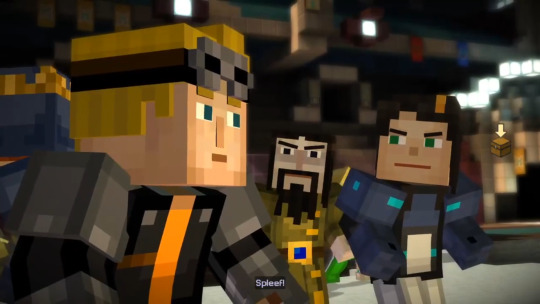
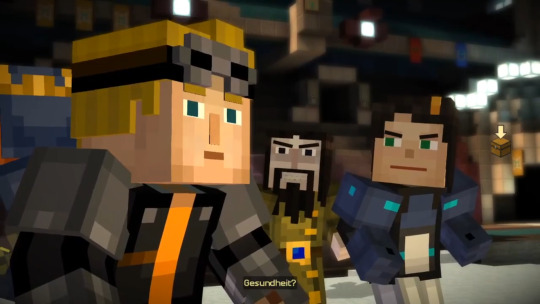
So, Ivor doesn't know what Spleef is. Until Lukas tells him that is. And that's kind of a big deal.
To be fair, this blink-and-you-miss-it moment doesn't actually help us discover anything new about Ivor as a character, but rather reinforce what we already knew. Allow me to explain.
Spleef is an incredibly well-known minecraft minigame. One of the oldest ones, way back from 2009 that defined Minecraft Multiplayer. The OG, the classic of Minecraft minigame sphere. If you play minecraft, and you don't know about it, you will. It's just that iconic. It was only a matter of time before it would be featured in Minecraft Story Mode.
Admittedly, the world of MCSM is vastly different from the meta minecraft that we're used to. The world of mcsm doesn't have an internet connection (although you could interpret the portal hallway as a network of different minecraft servers) and therefore the way characters in this world learn about the mechanics and other stuff is as limited as our real life world is. Because the characters don't have the meta we're so accustomed to (it's a whole topic of its own that I won't go into). And therefore it makes sense why the gang would not know about something as iconic as Spleef as that is likely not a part of their information pool.
Spleef (among The Walls and Deathrun) is one of the Old Builders' games. This OG status matches with our version of Spleef. So, it could be assumed that games like these would not be popular with the new generation. But Lukas is a scholar. And it makes sense for him to know about Spleef if it's something he's read in the books relating to building and architecture.
But why doesn't Ivor know? He is old. He and the rest of the Order of the Stone were the pioneers of their world. He LIVES in the Far Lands. He's old! Wouldn't he know about THE OG minigame? Well, he could have known about it, if he was interested in it.
At the end of the day, Spleef is a social game. And Ivor is anything but social. He was probably isolating himself in his lab when Spleef was popular. And his interests rarely lie in social events, so even with his giant book collection, I doubt he'd invest any time learning about games that include EUGH socialization.
I apologize if this is anticlimactic, but I thought it would be interesting to investigate, even if the answer is a nothingburger.
134 notes
·
View notes
Text
Hiiiii analyzing every part of the Subnautica 2 trailer that I can because I am unwell.

Starting off we have a diver in a deep empty abyssal-like area. Typically in the depths there is a source of bioluminescence or at least rock formations for light to reflect off of. The only place inside the game there’s this much empty darkness is the dead zone.
This could mean we have the chance to explore the dead zone! Or that there’s a new area that has similar features to the dark depths of the void.
This would be a banger feature to have considering how horrifying the dead zone is to traverse already. It would provide a new difficulty to the game if we had to confront or avoid packs of adult leviathans to progress.
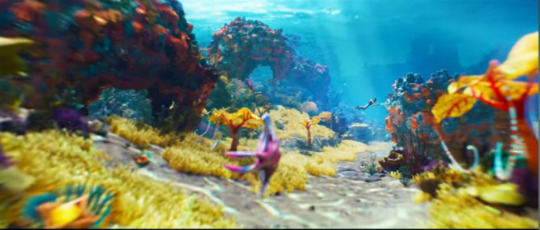
The trailer then shifts to what could be the safe shallows or twisty bridges equivalent in this game. It seems we’re getting what looks like a proper reef! It’s super neat to see the game being more colorful with its environment design.
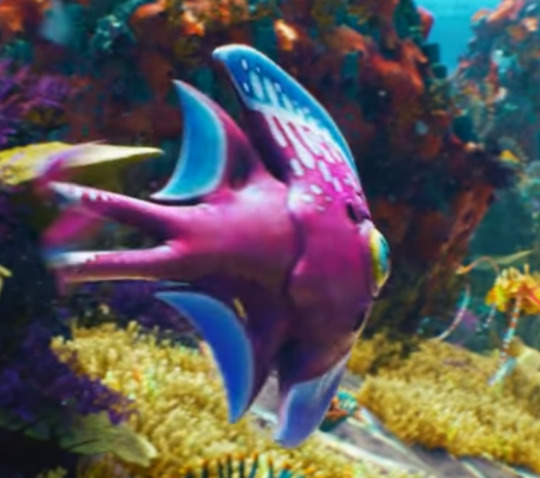
We also have a clear look at a new species of fish in this game. Considering its shape and large eye it could be a tropical/reef version of the peeper (or maybe the feather fish?). Or it could just be a new edible fish entirely!
All in all cool design. I do like how vibrant they look

Ok now for one of the most hype things in the trailer. Some sort of hermit crab based leviathan? It would be fascinating to have a leviathan that shows up in the shallows instead of only in deeper water. It could provide an additional challenge but I think this would be something similar to the reefback. Perhaps one of the elements of gameplay would be making it lift itself to access things hidden beneath it?
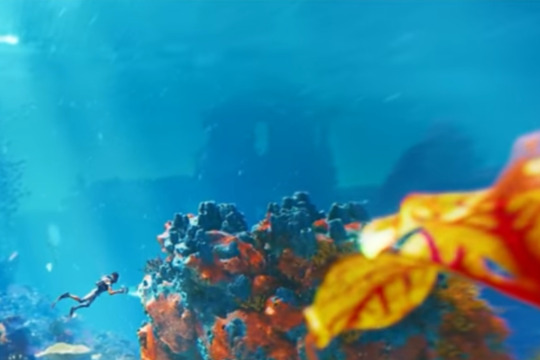

Next up we have what looks like an underwater city or at least a big building in the background. It’s pretty much a given there’s mysterious underwater structures in this franchise but I personally think it would be fascinating to have a proper Atlantis style city in Subnautica. This could also maybe incorporate the Architects into it? Like maybe after Al-An went to his home planet he brought back more Architects to cure the Kharaa and they set up a base.
Then again this also doesn’t exactly look like Architect architecture which is more of a cube structure. It looks closer like a temple’s architecture from what we can see. Maybe it could be a new alien species? That seems less likely
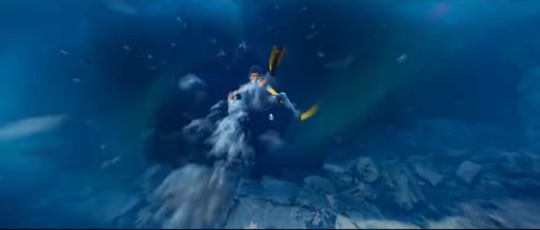
Next we have a specific feature that I am so hyped to see. It looks like Subnautica may be adding rip currants or something similar. Something that would actively make it more difficult for a player to swim to the surface. This would be so interesting because other than caves/islands/ice flows we generally never have something preventing us from going to the surface in Subnautica. Nothing actively pushing the player back at least. This would be a fresh new difficulty to get used to (if done correctly, at least. It could also be very annoying)

From there we get into something extra curious. It seems like we may have a second human in this game. Before Subnautica’s concepts have been based in the fact your character is alone on this planet with the odds against them. The way I see it, this addition can largely go three ways:
- a possible addition of a co-op system to Subnautica: unlikely, but it has been semi-popular in modding communities. People would have fun playing with their friends but I think it would take away from the horror aspect of Subnautica, one of its major draws
- a human companion that joins you in your journey: slightly more likely than multiplayer, but still not the direction I think they’d go. This could open the game to having puzzles that need two people and a companion could function similar to the sea monkey (bringing you needed items basically). This would also require a lot of AI and would probably be more annoying than anything else, however
- someone like Marguerite or Al-An that shows up in cutscenes and phone calls but mostly stays in one place: the most likely scenario. It could be we have a home base of sorts where this person is stays and gives the player hints and coordinates

Also as a note the vehicle she’s driving looks like a sea truck. Please oh please tell me it is not Sea Truck 2.0

Aaaand now we’re onto the most hype part of the trailer. We have a new leviathan!
This one looks a lot like a Kraken type with a bunch of limbs. It could maybe be related to the crab squids? Like a dead zone version of them? It could explain why it’s attracted to the vehicle
Or as a completely out there theory this could maybe be architect technology like the warpers? It may just be me but the way it moves its hands and its claws are very much reminiscent of heavier machinery. It would be so banger if the architects built themselves a leviathan.
Either way it would be fascinating to encounter a leviathan with the ability to seek out a grab a player with ‘hands’. Before creatures typically grab with their mouths or pinchers like the Reaper. This would be an interesting twist to learn to avoid
In conclusion I am unwell about this game and the theories are buzzing. I am so hyped
18 notes
·
View notes
Text
and here’s my theory about how the half life funny streams are a lot like dante’s inferno. no wait come back where are you going
so to start off with both of them are working within familiar architecture but end up flipping expectations on their head. the intended/imagined audience for both inferno & hlvr are already familiar w the framework the story takes place in. for inferno, it’s assumed that the audience are some sect of christian & thus believe in the ideas of hell/purgatory/heaven as well as the idea of different levels of sin significance. for hlvr, the audience knows the general plot & game mechanics of half life/hlalyx even if they’ve never played themselves, as well as knowing abt the concept of machinima and rtvs’ improv through internet (plus for hlage they had the context of hlvrai).
in inferno, hell’s physical design is very very important to the narrative (as well as purgatory and heaven but i haven’t actually read those two so moving on). i could say a lot about it but tldr the settings are described in detail and have a lot of meaning both thematically and literally. in hlvr there’s storytelling/worldbuilding through the environment as well. from the half life 2 wiki page:

partially this is just due to half life being a good game in and of itself. however the thing that inferno and hlvr have in common is that they take these pre-existing conceptual settings and add the creators’ own meaning to them.
in inferno, dante descends into hell, but when he reaches the very bottom where satan is he finds out that he’s actually been going up the whole time. to be clear he is going down but then he & virgil reach the bottom and have to do a 180 and go back up, but “back up” is actually transcending hell and beginning the ascension to purgatory. essentially you’re actually at the very very bottom/furthest from god when you’re on earth’s surface and you have to go through hell to get to heaven blah blah blah. map linked here if you’d like to see a visual. the point is that this isn’t the typical view of ascension to heaven and therefore not what the reader is expecting; the structure of hell & the world that dante presents is altered to make an impact on the reader and tell the story. hlvr is similar in that it’s the pre-existing game (moreso for hlage, but i’d argue that hlvrai is still half life, just in a platform allowing for multiplayer goofs) but altered to tell a different story. the journey of hlvr is still that of the original game but the ending (benrey in xen, the gnome in the vault) emphasizes the importance of the altered world around the characters as much as the other changes that have been made from the original games.
this brings us to another important thing, namely the fact that hlvr are still games being played. there’s a concept we used when we read inferno in class like a year ago where we talked abt two different guys named dante: dante the poet, who physically wrote inferno and came up with the ideas in it and whatever, and dante the pilgrim, who is the character we experience the story as. dante-pilgrim brings all his biases and thoughts to what’s happening and, most importantly, is the actual guy going on the journey physically & spiritually, whereas dante-poet has already (spiritually) completed this journey. dante-poet didn’t go on the journey physically bc that’s not how the world works, but he is writing and portraying dante-pilgrim to be the character of himself (dante-poet) as he developed spiritually throughout time. essentially dante-poet is writing from the end of the story because he already knows what’s going to happen and how he ended up here, whereas dante-pilgrim is witnessing the story start to finish bc he is the vehicle through which it is told.
the same principle can be applied to wayne. wayne the streamer, who is physically playing the game and thanking donos and editing the videos post-stream, and wayne the player, who is the Character Of Wayne. like. in hlage, wayne-streamer did not literally get turned into a gnome, but wayne-player did bc wayne-player exists as one of the storytelling tools that wayne-streamer & rtvs are using to write the narrative. for hlvr, the division of waynes is partially for practical reasons (imo, writing/editing/publishing a poem is not the same as Doing It Live, e.g. dante probably didn’t have to deal with the limitations/issues of his medium at the exact same time as he was writing the poem (i am not a dante historian though so don’t quote me on this)) but it’s also for narrative reasons bc wayne-player is a consistent character throughout the hlvr series.
like. obviously the gnome refers to him as gordon in hlage to connect w/ hlvrai and whatnot, but wayne-player is also consistent in his reactions/intent/behavior. (also, i can’t concretely say this is a wayne-player effect, but the similarities between the “big bad” of each game so far is also interesting to me. both the gnome and benrey vaguely antagonize wayne-player and express a desire to go back/stay put/deter him from the journey despite his own wishes. other gnome/benrey similarities: acting sus as hell and wayne-player disregards it either through party opinion or his own. “you made me like this … i was innocent before i met you” (36:07 in the hlage finale) and “i was supposed to be nice but you forced me to be baaaad”. presumably this pattern will continue in hl2vrai) i believe that even if it has little-to-no effect on hl2vrai, the whole end sequence of hlage (particularly the vault & theater/woods scene but we’ll get to that later) is a canon thing that happened to wayne-player that will end up affecting at the very least the conclusion of the half life 2 streams.
in terms of characters within the story, another place i see similarities is the limitations they experience. you could argue the gnome and benrey similarities are due to similar limitations that they experience as members of the trio referenced in the peppa pig movie, but i wanna look at a more specific example. returning to inferno: there’s a scene in canto 21 where virgil essentially asks for directions bc the road is closed and his google maps isn’t working. unfortunately bc he’s in hell there are only demons and sinners around to ask, so he asks a demon who lies to him and they have a momentary diversion bc of it. note that virgil’s limitations aren’t a secret or anything— he’s only dante’s guide for inferno bc he represents human reason, and then ascending past there he gets a special divine guide and the point is that human reason has limitations that god doesn’t have blah blah blah— but this scene does stand out as a Thing. virgil doesn’t intentionally lead dante astray, nor does he realize the demon is lying, but it’s still a thing that happens bc he’s fallible.
in hlvrai, coomer realizes some aspects of what is happening (the setting is a game, he’s a computer construct, wayne-player is not a computer construct, benrey is an unintended feature in the game, etc) but whether bc he physically can’t or bc he’s preoccupied, he does not seem to piece things together fully and come to the conclusion that he’s in hlvrai. likewise, according to wayne, the blue gnome is right but his limitation is that he’s a freak. right before his demise the blue gnome tells wayne not to make a mistake he “can’t even begin to know and understand” in taking the red gnome. unfortunately he’s so consistently horny in such a unique and upsetting way that it has ruined his credibility for anything ever even if he managed to be not horny about it. i have more thoughts on blue gnome’s role but this post is already going to be so so long.
anyway you could claim this is just a thing in all stories bc characters have to be unaware of or unable to do certain things bc that’s how plot progresses, but i think there’s something special about characters being unable to do or see something even though it seems like they should.
the final bit of hlage is what made me sit down and actually start writing this whole thing out so let’s get into it. comparing canto 34 lines 22-24:

to gabe newman’s final commentary box in hlage, i can see a lot of similarities. i think the vagueness of both can be at least partially attributed to how writing works; sometimes the most effect technique is just to hint at something rather than describe it fully bc the audience will mentally fill in whatever fits best for them personally. however, a lot of gabe’s lines (references to the obsidian seal, the dread and the nightmares, “and that was the day he appeared”, “do NOT proceed any farther”, etc) read to me very much like appeals to pathos in the same way that lines 22-24 are. like it hurts gabe & dante to even just reference, let alone recall, what they’re talking about. tbh i just greatly enjoy this comparison idk how much meat there is to it but it’s a good writing decision imo

the trio in the peppa pig movie (man in blue, little man in red hat, and someone else (she/her)) corresponds to benrey, the gnome, and whatever we’ll see in hl2vrai (possibly alyx's shadow but who's to say). they don’t really exist solely within their respective games and have some sort of influence on the outside world (this being another setting of the player, essentially wayne-player’s world rather than wayne-streamer’s world) as seen w/ the gnome theater scene. in the vault the gnome states that it wasn’t wayne-player’s challenge and that he (the gnome) has won; the clear assumption here is that it was the gnome’s challenge. however, i think it’s worth considering that the challenge may not necessarily be the gnome’s either. the peppa pig movie claims it was made by gordon (which would correspond to wayne-player, but obviously it wasn't) and the gnome supports this, even saying that the theater is gordon’s “mind palace”.
so, the question arises: is there another gordon of some kind? i don’t think it would be that far-fetched to say that there is a character within the hlvr series that wayne-player has been taking the place of (whether purposefully, knowingly, maliciously, or not) and since original gordon doesn’t have a place within the games, perhaps he is assuming the metaphorical place of satan here; a sort of container for the peppa pig movie trio when they are not participating in their respective hlvr games.
anyway some other things that i thought were interesting but not enough to write whole paragraphs on:
the autobiographical aspects of inferno compared to hlage being a reflection of wayne’s experiences
dante-pilgrim’s swooning as a way of transitioning in location compared to going to sleep as a way of transitioning between acts
it would be cool to find a stage adaptation of inferno and compare it to hlvr bc the formats would be more similar
something something how contrapasso is applied in hlvr (particularly hlvrai)
the professor who taught the class i learned this shit in would be really really upset if he knew i was applying my analysis to half life funny
obligatory disclaimers and qualifiers: i’ve interpreted the half life funny streams extremely seriously despite the fact that the purpose of 90% of it is half life funny. i only watched the hlage commentary stream when it originally aired and i didn’t bother going back to rewatch it so if anything i say here is blatantly untrue sorry. for the sake of simplicity i’ve referred to the stream on the 16th as hl2vrai because it’s probably gonna be some variation on that even if that’s not the exact title. the 16th stream (brbavrai) was not hl2 but i consider all of this to still hold true for hl2vrai. all inferno quotes were taken from the ciardi translation on archive.org
#hlvrai#hlage#radio tv solutions#wayneradiotv#rtvs#half life but the ai is self aware#half life alyx gnome edition#hl2vrai#half life vr ai#gordon feetman#post#i finish finals and immediately bust out the autism huh#anyway who's excited for the 16th? smile
39 notes
·
View notes
Text
I've been trawling through Steam lately to find my next big time waster of a game and I've realized something: Massively Multiplayer Online Games are a uniquely dead genre. Not truly dead in a sense that they aren't being made, but dead in the sense that they have been subsumed by the industry at large.
As someone who really, really got in to MMOs in the late 90's early 2000's it is disappointing to see. There was something uniquely special about games with a persistent, shared world that you can wander and encounter people who are also wandering it. Despite the fact it was largely a theme park, you could have the illusion of it being a living world pretty easily by how many other people you could interact with.
They set the industry on its current path: Retail base copies, expansion packs, and subscription fees: Games As A Service started with MMOs. You were selling players their "Forever game". High initial development costs and investments were a bit of a gamble, but the payoff was huge: Instead of selling a single game on a release schedule, you had a constant flow of money coming in. For developers, this also meant that you had a pretty stable job in an industry that was hire-and-fire for releases. A good example of this is to look at Digital Extremes pre-Warframe, and how making a GAAS changed their studio.
MMOs were a highly competitive market, however: They monopolized the player's time (and money) in a way that other games didn't. In serial, retail releases: who cares if the player went on to another game? You got their money already. But in MMOs, this was cutthroat because players only had so much time or money to devote to games. UO was usurped by EQ, and EQ was usurped by WoW and there were dozens of very expensive corpses on the path there.
Many MMOs shot for (and failed to be) the fabled "WoW Killer". Many would argue that WoW's "failure" is Blizzard's own fault - but the truth was that the market moved beyond MMOs because they were able to extract the pieces from the genre that motivated players: Progression, persistence, prestige, community, FOMO.
Suddenly you could get that same dopamine hit from getting that cool, rare item and you could do it while playing a shooter looter (Destiny.) Or you could play an Diablo-like ARPG and chat with people in a text box in real time as if you were in a leveling area even if you ever actually were in the same game as them (Path of Exile.) People were able to find their particular favorite gameplay style now infused with the cool parts of MMOs.
I think these are actually net positives - I think that progression and persistence go a long way towards making a game feel unique and giving you good stories to tell your friends about them.
But this left MMOs with only one thing that really set them apart: Persistent worlds. The problem with this of course is that the computational cost of persistent, shared worlds has never really gotten easier. The more you scale up the number of people in the same world/area, the more expensive it becomes, so MMOs never really got cheaper. To boot, in a market with endlessly ballooning development costs, it was hard to justify. Hell, even World of Warcraft eventually realized the solution was to shard out the zones with smaller player caps than the traditional server architecture.
FFXIV and WoW are out there still "going strong". There's a number of die-hard players who have truly accepted it as their "Forever game" in the way that many people only buy the serial releases of COD / Fifa. World of Warcraft exists in a persistent state of reinvention (What if we restarted from the beginning?) whereas FFXIV feels like it's the opposite - holding on to a deep, stable stagnation because that's what the players find comfortable.
In my opening post, I did call MMOs a "uniquely dead genre." And although we occasionally see new games released, I want to underline that these are zombies. For example, Amazon released "New World" in 2021 to a staggering 900k Peak Concurrent players. It's currently sitting at less than 10k averages.
Not to mention that from a perspective of preservation/archiving games - MMOs die off in a way that makes them impossible to revisit later. Sure, server emulation exists for a few, but no emulation is perfect. Plus, it's impossible to "emulate" the game as it was intended - with a population of players interacting with the world around you.
2 notes
·
View notes
Text
remember mapcrunch, that game we were all playing like 13 yrs ago, where it drops you at a random google earth street view location and your goal is to get to the airport
was told about a similar game called geoguess, which does the same thing but the goal is to pinpoint where on earth you think you are and you're scored on how close you got. which is ABSOLUTELY my kinda game, but you only get three free chances per day.
BUT then i heard about a free alternative called geotastic and it is better and has several game modes anyway (including multiplayer if you're into that). and it seems to be a cool site run by one guy who crowdfunds it. there's a big banner at the top of the page saying how far it is from the monthly upkeep goal. if you're a user you can watch an ad to play for free or make a donation and not have to watch ads anymore (only has to be 1 Euro or more to overcome paypal fees so I paid a couple bucks and that was it). and there is currently a cute advent calendar feature!!!!
anyway i am having a blast. I think i was good at mapcrunch and I am not bad at this one either. it's fascinating to notice how the trees and the sky are different in certain parts of the world, which can help you even if you're unlucky enough to be dropped in the middle of nowhere. but I have an advantage in town from being a linguist since I can usually identify the language or at least the script on signage and stuff. This feels like cheating. Also not helpful when you get get English signage, tropical plants and ramshackle architecture and don't know whether you're in the Caribbean somewhere or in Africa. those are usually the only times I am super off. anyway highly recommend
5 notes
·
View notes
Text
I have been thinking about how I am exactly the type of person who can actually really enjoy grinding in video games (at least if it's done properly).
I know that this is unusual since grinding is generally considered a negative about a game, but I have a small essay mentally prepared to explain what I like about it and what types work best for me.
To explain it in my signature horny way: I think a good grind is kind of like entering a hypnotic trance. Your thoughts and stress fade away and you focus only on the task ahead. You stop worrying and stressing and instead think only of making numbers go up.
This can be really pleasant to certain mental architectures.
But I think there's also certain factors that can make grinds better or worse, at least from my subjective point of view.
1- The most important thing is that I think a good grind should have some form of constant and tangible forward progress.
In most games, this means gaining experience and leveling up, with things like rare item drops usually being just a nice bonus. It's important for these levels to actually do something significant for you too.
For example, new abilities, new opportunities, access to new tiers of power, etc. It should not just be a barely-perceptible stat increase like a +1% to piercing damage or an extra +2 strength points added to the 60 you already have. Stuff like that doesn't feel like it changes your power level at all.
And it's not just about getting noticeably stronger either. Ideally you should also be unlocking new activities to do, new mechanics to play with, new places to visit, and so on. Even if it's a long total grind, it feels a lot better if it's broken up into smaller sections where you're even slightly changing activities as you unlock more of them.
I have more mixed feelings on stuff like grinding for rare items exclusively. That ends up feeling significantly more binary if you're not also getting some other meaningful reward in the process. It still feels satisfying when whatever you were hunting for finally drops, but until then it feels a lot more tiring without the frequent dopamine hits.
For example, grinding for rare pokemon to catch did not feel nearly as fun to me as grinding for levels in something like Wizardry 8.
2- A good framework for the grind.
Related to the above: Grinds that give you an extreme objective from the outset are harder to enjoy even if you are making constant progress towards them, and that's if you even remember them consciously.
It helps to instead have a bunch of smaller (and relatively varied!) grinds rather than a single extreme one, and then you move on to a different place to do a different set of smaller grinds.
Also on the topic of frameworks, some cool and distinctive aesthetic reward can make the grind more satisfying. I am more likely to be excited if what I'm grinding for is a cool vampiric ability or an item that looks great rather than just the mandatory next tier of advancement.
3- Some social option.
I don't necessarily mean that the game has to have multiplayer or anything, but it can be nice when it is slow and passive enough that you can talk to your friends through text as you play, just so you're still getting your interaction with them and keeping them up to date on your milestones and progress and all. Grinds that require less interaction like that are also nice in that they require less mental effort.
This is not all there is to it either... many factors go into this kind of thing.
17 notes
·
View notes
Text

Warhammer 40,000: Space Marine - Blast Review
Developer: Relic Entertainment Steam Deck Compatibility?: Playable Rrp: £27.99 (Gog.com) - Base Version £31.99 (Steam) and £39.99 (Humble) - Anniversary Edition
Please note that the version of the game I played was not the Anniversary Edition and did not come with multiplayer or the DLC’s relating to that. However, the version I have does come with all the other extra bonuses that Anniversary Edition includes such as the soundtrack etc.
Since the sequel has recently come out I thought I’d check out the previous one and I have to say I wasn’t disappointed at all. Being that this game is quite a bit older (having come out in 2011) it doesn’t have the more crisp looking graphics of its sequel and brown is definitely the more predominantly used colour for most of the game. That being said, the level and overall architectural design really do wonders to capture the feel of the universe in which this game is set.
What’s quite interesting about this game is that initially it looks like it's supposed to play like something like Gears of War, where you’re going from cover to cover trying to shoot the enemy and that melee combat is to be avoided for the most part. That isn’t the case here, sure your guns are powerful but this game wants you to be in the thick of melee, there are no chest high walls for you to cower behind. The ranged weapons you have are mostly there to thin the herd, not eliminate them entirely. This is reinforced by the fact that the only way you can regain health is by stunning enemies and executing them in melee, similar to the glory kill system in Doom 2016.

I had a real blast playing this game and I highly recommend giving it a go. Also what’s quite interesting is the fact that this game is actually a prequel to Boltgun and is set on the same planet.
---- If you’d like to support me I have a Ko-fi, the reviews will continue to be posted donation or not.
#game review#games review#game reviews#games reviews#video games#video game#video gaming#warhammer 40000#warhammer 40k#Space Marine#Third Person Shooter#Relic Entertainment#blast review
2 notes
·
View notes
Note
Saw your recent posts about deathloop and I've never heard of it before but oh myyy goddd it sounds intriguing, considering getting it but I know next to nothing about it really tbh. Do you think you could like give a summary of it or what you liked about it? Sooo fair to be like no go Google it instead lmao, I just love hearing first hand accounts of people playing a game yk, it gives me more of an impression of the game sometimes but also I know people don't wanna explain shit all the time haha
I will never in my life tell someone to google something instead of explaining what i like about it because i love to talk about things i like <3333
I definitely recommend getting it!!! It's one of my favorite games of all time and imo so incredibly underrated. The vague plot summary is you are an amnesiac assassin trapped in a time loop attempting to break the time loop by assassinating your targets, all while being targeted yourself by a woman who claims to know everything about you. I don't want to say too much because I think it's best played going in as blind as possible, but it engages a lot with cycles of violence, capitalism (my favorite trope of rich idealists fuck off to an island to build a better society and realize they can't stand each other), violence as intimacy, and the complexities of family relationships.
I personally love deathloop most for its character relationships and environmental storytelling! The relationship between Colt (you) and Julianna (the assassin targeting you) is the engine the whole game runs on and the voice actors have this really believable conversational chemistry. But each of the side characters also have their own unique relationship with Colt and each other, as well as their own secrets and psychological issues that you can dive into as deeply or shallowly as you want. And the environmental storytelling is on a level I think many AAA games are still trying to find in that it goes beyond just finding notes on the ground or whatever. The whole game is set on an island that has layers and layers of history that you can see through the changing architecture and faded signs and graffiti, it's incredibly cool.
As you can tell from these descriptors it's definitely a game that gives back what you put into it - if you wanted to you could breeze past all this and just play it as a straight immersive sim shooter but imo that is not as rewarding. You also probably won't enjoy this game if you don't want to find new ways to play the same levels over and over - it's set in a time loop after all! I personally am the kind of person who loves to explore and master game environments so it fit right into my natural playstyle. I will say multiplayer is completely broken and unfortunately the lack of fans means it's probably not going to be fixed any time soon, but the base game is so strong it's really just a fun extra.
anyway. play deathloop. goodbye
2 notes
·
View notes
Text
Hi
Some new people followed in the last couple of days, so I thought I'd post some links related to this project- The images here evolved out of a project called *Grotto*, which is a multiplayer browser game where I turned my family tree into a 1000+ room dungeon. It's a little confusing and maybe not entirely fun, but it was the first place I started developing the tile-art style on this blog. You can check it out here- http://mudroom.rip Most of the images on this blog were from another project, where I did several hundred experiments with the tiles I had created. There's a book of these, which maybe I'll do print on demand of some day. I also wrote an article about arcologies, videogames, power and architecture that accompanies it. My process journal for this project is here- http://wileywiggins.com/archon.html Right now I'm actually making a functional roguelike videogame using the tileset. It's sort of working, but so far all you can do is get burned to death by a Basilisk. I'll start a new project page for that once it gets out of the experimental phase. Here's what it looks like now-
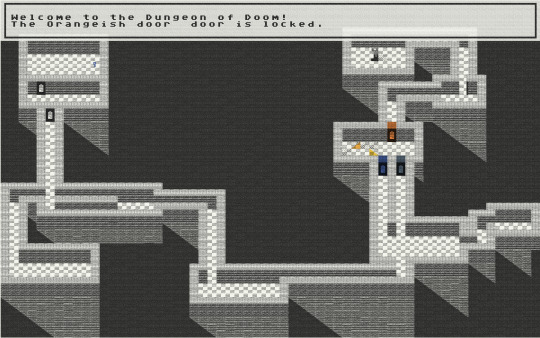
also, to answer another question, yes I was Mitch in Dazed and Confused. I am a cranky old man now. I don't generally try to make movies any more because this stuff is cooler. However, if you enjoy the grainy, confusing black and white imagery on this blog, you may also enjoy my movie *Computer Chess*, which is about to get a new US Blu-Ray edition this month.
3 notes
·
View notes
Text
here are some games i want to see going forward:
a multiplayer game that makes it easy to get a dedicated team (in a social way)
combine soulslikes and MMOs. i want to see what can happen there.
indie liberal cottedgecore game but with fun gameplay to someone who struggles with making good architecture and would rather fight stuff
seemingly cartoony deconstructions of regularly dark game generas (not horror) that quickly shows how brutal it can truly be (i want more games like another crab's treasure please)
types of games we can stop making:
dedicated esports thing
pvp shooters where you die in .65 seconds
indie liberal cottagecore "wholesome" games
"edgy" "deconstructions" of a genre that are just The Genre But Done Badly
14K notes
·
View notes
Text
Best Practices from Game Development Companies in India for Mobile App Developers
The mobile app development landscape is evolving at a rapid pace, and developers are constantly looking for ways to improve engagement, performance, and retention. One of the most powerful sources of inspiration? The thriving ecosystem of game development companies in India.
Game developers are masters of user engagement, real-time performance, and compelling user experiences. These are the very pillars mobile app developers aim to strengthen. As such, adopting best practices from game development companies can give mobile apps a much-needed edge in a crowded marketplace.
Let’s explore how mobile app developers can benefit from the experience and strategies of India’s top game studios.
1. User-Centric Design and Flow
Game developers build experiences that capture user attention within seconds. Indian game development companies, known for designing hit games across genres, emphasize intuitive interfaces, smooth onboarding, and seamless navigation.
Best Practice: Adopt a game-like onboarding flow that teaches users how to use your app interactively. Include small rewards or feedback after initial milestones to retain users during the critical first few minutes.
2. Iterative Development and Continuous Testing
Game development is rarely a “build once and release” process. Instead, it's highly iterative. Indian game studios use feedback loops, A/B testing, and analytics to constantly tweak game mechanics.
Best Practice: Implement frequent updates and use real-time analytics to monitor app performance and user behavior. Adopt tools like Firebase or GameAnalytics to test and optimize features before full rollouts.
3. Retention Through Gamification
Gamification is one of the key strengths of game developers. Indian companies are experts at integrating point systems, badges, leaderboards, and streaks to increase retention.
Best Practice: Use gamification in your app—even if it’s not a game. Loyalty rewards, user levels, daily check-ins, or progress tracking can make apps more addictive and fun.
4. Cross-Platform Development with Unity and Unreal
Top game development companies in India often use powerful tools like Unity and Unreal Engine for cross-platform development, allowing them to launch products across Android, iOS, and web with a single codebase.
Best Practice: Consider using cross-platform game development tools to streamline your development process. Even non-game apps can benefit from Unity’s flexible UI design and animation capabilities.
5. Lightweight Design for Performance Optimization
India-based developers are particularly skilled at optimizing games for low-end devices due to the diversity of the market. They prioritize memory efficiency, low battery consumption, and offline modes.
Best Practice: Focus on performance early in the development cycle. Ensure your mobile app runs smoothly on lower-spec devices, especially in emerging markets.
6. Scalable Backend Systems
Game developers often build apps for millions of concurrent users. They rely on scalable cloud services and robust architecture.
Best Practice: Use backend-as-a-service platforms or scalable cloud environments like AWS, Firebase, or PlayFab to future-proof your app’s infrastructure and handle user growth without performance issues.
7. Community Building and Social Features
Games thrive on social interaction—multiplayer options, leaderboards, friend invites, and social sharing. Indian game development companies frequently integrate these to create active communities.
Best Practice: Add community features such as discussion boards, in-app chats, or social sharing to increase user interaction and organic reach.
Why India?
India is home to world-class talent, competitive pricing, and a rapidly growing tech ecosystem. Leading companies like ApperStudios, among others, are setting new benchmarks in both game and mobile app development by blending technical excellence with creative innovation.
Final Thoughts
The line between mobile apps and games is increasingly blurred. By learning from game development companies in India, app developers can deliver apps that not only work well but also engage users in ways that keep them coming back.
Whether you’re a startup or an established mobile app development company, embracing these practices can help you create high-performing, engaging, and successful mobile experiences.
0 notes
Text
Unlocking Wealth Through Metaverse Game Development

The world of game development companies is evolving at a rapid pace, and the Metaverse stands at the forefront of this transformation. With virtual environments becoming more immersive and interactive, businesses are racing to create the next big metaverse game that blends entertainment, social interaction, and digital ownership. For entrepreneurs and investors, this presents an unprecedented opportunity to build innovative experiences and tap into a billion-dollar market.
Whether you’re a brand aiming to enter the digital realm or a startup with a groundbreaking idea, leveraging expert Game Development Company Services is your first step toward success.
Why the Metaverse is a Goldmine for Game Developers
The Metaverse combines virtual reality (VR), augmented reality (AR), blockchain, and AI to create persistent digital worlds where users can socialize, work, and play. Game Development Companies are tapping into this technology to craft games that go beyond traditional formats — offering real economies, NFTs, and immersive storytelling.
From play-to-earn (P2E) models to token-based marketplaces, Metaverse games empower users to monetize gameplay. It’s not just a trend — it’s a new digital economy.
What Makes Metaverse Games Different?
Metaverse games are more than just entertainment; they’re platforms for interaction, commerce, and creativity. They enable users to:
Own and trade digital assets (NFTs)
Earn cryptocurrency
Interact in real-time with other players globally
Build and customize virtual spaces
To create such complex ecosystems, you need comprehensive Game Development Services including blockchain integration, AI-driven NPCs, multiplayer networking, and 3D asset creation. That’s where a professional Game Development Company comes in.
Want to Build a Metaverse Game?
Book an Appointment with our expert developers to discuss your idea and get started.
Choosing the Right Game Development Company
Selecting the right partner can make or break your project. When exploring options, consider:
Experience with Metaverse tools like Unity, Unreal Engine, and Web3 frameworks
Portfolio of successful Metaverse or P2E projects
Blockchain and crypto integration capabilities
Scalable multiplayer infrastructure
Looking for a trusted Game Development Company in the UK? Our team provides end-to-end solutions from concept to deployment, tailored to your unique vision.
Understanding Game Development Cost
The Game Development Cost for Metaverse experiences vary based on factors like:
Complexity and number of features
Technology stack (VR/AR integration, blockchain, etc.)
Design depth (3D environments, avatars, custom skins)
Server architecture and multiplayer setup
On average, developing a Metaverse game can range from $50,000 for a simple MVP to $500,000+ for full-scale platforms. With the right investment and guidance, the ROI can be exponentially higher.
Hire Game Development Developer: What to Look For
If you want to Hire Game Development Developer for your Metaverse project, prioritize:
Proficiency in 3D engines (Unity, Unreal)
Knowledge of Web3 and blockchain platforms
Experience with multiplayer gaming logic
Creative storytelling and UI/UX skills
Instead of hiring freelancers who may lack consistency, partnering with a seasoned Game Development Company ensures quality, accountability, and scalability.
Final Thoughts
Metaverse Game Development isn’t just about building games — it’s about creating digital worlds where people live, work, and earn. With the right team and strategy, your game could be the next major platform in this growing ecosystem.
Whether you're looking for a full-service studio or specific Game Development Service, now is the time to act. Let a top-tier Game Development Company in the UK guide you from concept to success.
0 notes